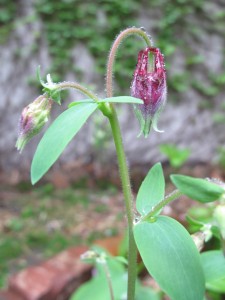
columbine
Last wednesday I took a class entitled Creating a Rain Garden at the Brooklyn Botanic Gardens. It was a free class through their community horticulture program called GreenBridge. I hesitate for purely selfish reasons to talk about them, because they offer the most amazing classes free of charge and they fill up very quickly. Okay, there, I did it. You should definitely check out their classes. They have composting workshops, container gardening workshops, seed starting, etc. I will be taking their Edible Landscape class in June. I think all of the classes for the spring are filled up at this point, but you can get on their mailing list for future classes.
At the start of the class, we took a walk through the gardens. We walked through the cherry esplanade, which was in full bloom. The garden was closed to the public, so we were alone there at dusk. We passed through the lilacs and their perfume lifted me off my feet. We then walked through the native plant section of the garden, which is a nice, private section of the garden. There were lots of bunnies out and Robin, our teacher, said that there are wild dogs in the garden that come out at night, but are very shy. The walk was magical and now I have to figure out how to get a job there!
So what is a rain garden? A rain garden is designed to soak up rain water, especially from roofs, driveways, patios, etc. They look like a regular garden, but help to prevent valuable water from running off to the sewer system. You chose a site that has a slight downhill grade, or you dig a small depression that encourages the collection of rainwater. Many communities plant rain gardens in the green space between the sidewalk and the street. They cut the curb in front of the garden, which allows the rain running towards the storm drains to water the garden. If that isn’t clear, here is an example, which gives instructions as well.
One important thing to note about rain gardens is that they aren’t ponds, and therefore won’t attract mosquitoes. Sometimes they are filled with water after a rain, but other times they are dry. This requires plants that can handle both wet and dry conditions. That brings me back to one of my favorite topics…native plants! Native plants thrive in your area, which means they are adapted to live with the weather you get. (ie. temperature and rainfall) Once they are established, you won’t have to pamper them as you do with exotic species. You also have the added benefit of attracting loads of wildlife to your garden in the form of butterflies, bees and birds. And probably my personal nemesis the squirrel.
Okay, back to the rain garden…Think of the garden as a bowl, or as my teacher said, a pie plate. In the center of the garden, which is the bottom of the depression, you will collect the most water. You will want plants that can handle wet conditions. On the edges of the garden, there will be a slight incline, so the conditions will be dryer. You pick different plants for the dry conditions. Here’s a list of native plants that thrive in the different conditions in NYC. Actually these plants would be appropriate for most of the Northeast.

solomons seal
By the end of the class, I realized that I wouldn’t be able to handle the quantity of water that runs off my roof when it rains, so I’m going to concentrate on planting more native plants that require less watering. I think I may also plant around the tiny tree in the pit outside my apartment. Right now there’s just dirt around it. Other people could think about green roofs as a way to absorb rainwater and prevent runoff.
Here are some factoids to encourage you to think about rain gardens:
* In the summertime 40% of our water use goes to watering lawns and gardens. Rain gardens rely soley on rain, so they don’t waste valuable resources.
* Rain gardens allow 30% more water to soak into the ground than a regular lawn.
* 300 million gallons of sewer overflow (rain runoff mixed with good old regular sewage) are diverted to the Gowanus canal each year. Other overflow goes to Orchard beach, Jones beach and others, causing them to close due to unsafe bacterial counts. Euw!

Pingback: Rubble for soil | The New Green